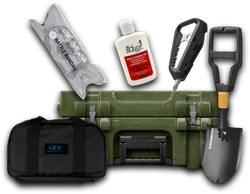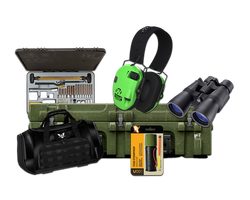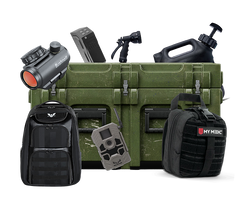Understanding How FN FAL Works: A Deep Dive into the Iconic Battle Rifle
Table of Contents
- Introduction
- The History of the FN FAL
- How FN FAL Works: Mechanism and Design
- Variants of the FN FAL
- The FN FAL in Tactical Applications
- Conclusion
- FAQ
Introduction
Imagine holding a piece of history in your hands—a weapon that has shaped the course of modern warfare and has been adopted by over 90 countries. The FN FAL, known as the "Right Arm of the Free World," is not just another rifle; it is a symbol of military capability and versatility. Designed in the 1950s by the Belgian firearms designer Dieudonné Saive, this battle rifle has stood the test of time, being utilized across various conflicts and environments worldwide.
The FN FAL is a gas-operated, selective-fire battle rifle chambered in 7.62×51mm NATO. Its design incorporates advanced features that allow for adaptability in diverse combat scenarios, making it an enduring choice for militaries and civilian enthusiasts alike. This blog post aims to provide a comprehensive understanding of how FN FAL works, exploring its design, functionality, historical significance, and implications in modern tactical applications.
By delving into the intricate mechanics of the FN FAL, readers will not only gain insight into its operational principles but also appreciate the craftsmanship and engineering that make this rifle a favorite among tactical professionals and enthusiasts. As we unpack the complexities of the FN FAL, we will touch upon its various configurations and the role it plays in the broader context of firearms and military history.
Get ready to embark on a tactical journey that will enhance your knowledge of this remarkable rifle and its place in the world of firearms.
The History of the FN FAL
Origins and Development
The FN FAL's story begins in the aftermath of World War II, during a period of rapid military innovation and development. In 1946, FN Herstal sought to create a new battle rifle that could meet the demands of modern warfare. The initial design was influenced by the German Sturmgewehr 44, which utilized an intermediate cartridge, leading to the prototype's chambering in 7.92×33mm Kurz.
However, after various evaluations and recommendations, the FN FAL was eventually redesigned to accommodate the 7.62×51mm NATO cartridge. This change was pivotal, as the NATO standardization efforts aimed to unify ammunition and firearms across member nations. The FN FAL gained traction among NATO forces, becoming a staple battle rifle for numerous countries throughout the Cold War era.
Adoption and Global Impact
By the 1950s, the FN FAL had been adopted by several NATO countries, including Belgium, Canada, and the United Kingdom (as the L1A1 Self-Loading Rifle). Its robust design and adaptability made it a favored choice among military forces worldwide. The rifle's reputation for reliability and accuracy allowed it to excel in various combat scenarios, from conventional warfare to counterinsurgency operations.
The FN FAL's impact extended beyond NATO nations; it was also adopted by various countries in Africa, Asia, and Latin America. Its widespread use can be attributed to its versatility and the ability to function effectively in diverse environments, from urban settings to rugged terrains.
The FN FAL Today
Today, the FN FAL continues to hold relevance in military and civilian contexts. While newer firearms have emerged, the FN FAL remains a respected choice among collectors and shooting enthusiasts. Its legacy as a battle rifle is enduring, with many variants still in use by military and paramilitary forces around the globe.
How FN FAL Works: Mechanism and Design
Operating Principle
At the heart of the FN FAL's functionality is its gas-operated mechanism. The rifle employs a short-stroke gas piston system, which allows for reliable cycling of the action. When fired, gas from the fired cartridge is diverted through a port in the barrel to drive a piston that operates the action. This design minimizes recoil and enhances control during rapid fire.
Locking Mechanism
The FN FAL features a tilting breechblock locking mechanism. When the bolt is closed, the breechblock tilts downward into a locking recess in the receiver, securing the chamber and preventing the escape of gas. This robust locking system contributes to the rifle's overall safety and reliability.
Gas Regulator
One of the standout features of the FN FAL is its adjustable gas regulator, located just behind the front sight base. This allows the shooter to adapt the rifle's gas system to accommodate different ammunition types and environmental conditions. For example, in adverse conditions, the regulator can be adjusted to ensure reliable operation, making the FN FAL a highly adaptable weapon.
Magazine and Feeding System
The FN FAL is fed from detachable magazines, with capacities typically ranging from 5 to 30 rounds. The most common configuration uses a 20-round magazine. The magazine is inserted into the rifle's magazine well, and a simple pull of the bolt handle loads the first round into the chamber. The rifle's feeding system is designed for smooth and reliable operation, ensuring that each round is fed into the chamber without fail.
Safety Features
Safety is paramount in any firearm design, and the FN FAL incorporates several safety features. The rifle includes a manual safety that prevents accidental discharge, as well as a robust construction that withstands the rigors of combat.
Variants of the FN FAL
Military Variants
The FN FAL has seen numerous military variants, each tailored to meet the specific needs of different armed forces. Some notable variants include:
- FAL 50.00: The standard original model, widely used by NATO forces.
- FAL 50.41: A heavy-barrel variant designed for sustained fire, often used as a light machine gun.
- FAL 50.63: A paratrooper version with a shorter barrel and folding stock for improved portability.
Civilian Variants
In addition to military versions, the FN FAL is available in civilian configurations. These rifles are generally semi-automatic and are popular among collectors and shooting enthusiasts. Manufacturers like DSArms produce civilian variants that maintain the reliability and performance of the original design while complying with legal restrictions.
International Variants
Countries that adopted the FN FAL often produced their own versions under license. For example, the L1A1 in the UK and the R1 in South Africa are both derivatives of the original FN FAL design, showcasing how adaptable the rifle is to various manufacturing processes and requirements.
The FN FAL in Tactical Applications
Effectiveness in Combat
The FN FAL has proven itself in numerous combat scenarios, from conventional warfare to asymmetric conflicts. Its chambering in 7.62×51mm NATO provides substantial stopping power, making it effective against both personnel and light vehicles.
The rifle's adjustable gas system allows for reliable performance in diverse environmental conditions, an advantage for soldiers operating in various theaters of war. Additionally, the FN FAL's accuracy and manageable recoil make it a preferred choice for marksmen.
Role in Modern Military Operations
While newer rifles have emerged in the modern landscape, the FN FAL remains relevant. Some military forces continue to utilize the FN FAL in designated marksman roles, taking advantage of its accuracy and effective range.
In a tactical context, the FN FAL can be employed in various roles, from standard infantry combat to special operations. Its adaptability allows for customization with optics, bipods, and other tactical accessories, making it suitable for various mission profiles.
Conclusion
The FN FAL is more than just a rifle; it is a testament to the evolution of firearms technology and military strategy. Its design, characterized by a gas-operated action, adjustable gas regulator, and robust locking mechanism, ensures reliability and effectiveness in combat.
Having been adopted by numerous countries and utilized in diverse conflicts, the FN FAL has cemented its place in military history. Today, it continues to be appreciated by collectors and tactical enthusiasts alike, with various military and civilian variants available.
By understanding how FN FAL works, you can better appreciate its significance and role within the broader context of firearms and military operations. Whether you are a seasoned shooter or new to the tactical world, the FN FAL offers a rich history and a robust platform for various applications.
FAQ
What is the effective range of the FN FAL?
The effective range of the FN FAL typically falls between 400 to 800 meters, depending on the variant and the ammunition used. Its accuracy and stopping power make it effective for engaging targets at these distances.
Can the FN FAL be used for civilian purposes?
Yes, civilian variants of the FN FAL are available and can be used for recreational shooting, hunting, and collecting. However, these variants are generally limited to semi-automatic configurations.
How do I maintain my FN FAL?
Regular maintenance of the FN FAL includes cleaning the barrel, action, and gas system. It's essential to keep the rifle free from debris and lubricated to ensure reliable operation. Always refer to the manufacturer's guidelines for specific maintenance instructions.
Is the FN FAL still in production?
While the original FN FAL is no longer produced in large quantities, several manufacturers still produce variants of the rifle. Companies like DSArms offer modernized versions that maintain the design's core principles while integrating contemporary enhancements.
What accessories can I use with the FN FAL?
The FN FAL can be customized with various accessories, including optics, bipods, and tactical lights. Its design allows for a range of attachments, enhancing its functionality for different applications.
By embracing the principles of tactical preparedness and high-quality gear, Crate Club offers an array of products that can complement your FN FAL experience. Whether you’re looking for tactical accessories, survival tools, or just the right gear to enhance your outdoor adventures, consider exploring our Crate Club Subscription Services and Crate Club Shop for curated options tailored to your needs.
Share this article



